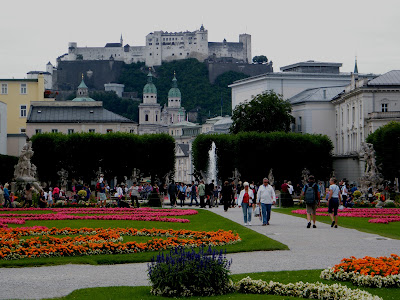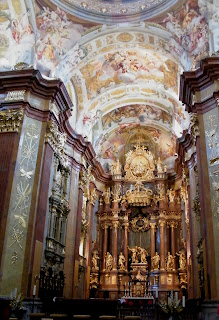Hi Everyone
I've just sent an article to the "Weekend West" Travel editor. Click on the link below and Open in Word to have a look.
I hope he likes it!
Cheers for now.
Julie.
Splendours of Europe
Wednesday, 26 September 2012
Monday, 20 August 2012
Post Script
Thank you to all the people who have viewed my blog and provided me with such positive feedback.
Whilst we were on our river cruise, we were filmed for a new travel show "Tour the World" which will be premiering on our television screens in February 2013. As soon as I have a copy of the youtube link, featuring our trip in their first episode, I will post it to my blog.
In the meantime, I have included a link to their pilot show (top right), filmed in Cambodia, to give you a taste of things to come.
Have a look and enjoy!
Whilst we were on our river cruise, we were filmed for a new travel show "Tour the World" which will be premiering on our television screens in February 2013. As soon as I have a copy of the youtube link, featuring our trip in their first episode, I will post it to my blog.
In the meantime, I have included a link to their pilot show (top right), filmed in Cambodia, to give you a taste of things to come.
Have a look and enjoy!
Julie
Monday, 6 August 2012
Prague
Whilst Bratislava, Budapest and Prague are beautiful, historic, romantic cities, you don't need to travel too far to observe remnants of the communist era.
The grey, communist flats have been brightly painted since the iron curtain fell less than twenty years ago as the Hungarians, Slovaks and Czechs attempt to erase all reminders of this period of their history.
An ugly little car such as this, if you were brave enough to buy it during those shadowy decades, would need to be paid in full upon signing the purchase papers. If you were lucky, you would receive your car five years later - if not, it could take up to eight years for delivery.
Prague is a magical city of bridges, cathedrals, gold-tipped towers and church domes dating back to the 9th century.
The clocks on this church tower date back to the time when two clocks were required to show the time - the one above for hours and below for the minutes.
By the time the Astronomical Clock was built in 1410, knowledge of time had advanced to the point where, not only were the hours and minutes on the same dial, the earth, sky, sun and moon were all incorporated into the one device, which is still in operation today, 600 years later.
But Prague, for me, is a city of contrasts, where beautifully preserved gothic and baroque buildings exist grandly beside the peeling paint of neglect.
Where street vendors' delicious aromas of roasting beef, potatoes, corn are sharply overtaken by that of the sewerage below, struggling to cope.
Where filthy cigarette butts fill gaps in the carefully patterned street stones, polished clean by centuries of wear.
Where it is easy to lose yourself in the crowded maze of narrow streets yet miraculously find yourself at recognisable landmarks.
Oh - and the shops full of amber and crystals and garnets have taken me under their sparkling spell!
I am so happy and grateful to have had the opportunity to lose myself in this magical city.
The final curtain
And we’ve had our final dinner (with an exclusive invitation
to dine with the captain!)
My mum, it's clear
Is loved by so many new friends – she’s a winner
Her cruising life was full
She travelled each and ev’ry byway
And more, much more than that, she did it her way
Regrets, there were none
(Well, that’s my mum…)
She did what she wanted to do
Even being interviewed by a television crew
And was inspired to sing the Sound of Music, in Saltzburg
She was reunited with old friends from Cootamundra
And was fascinated with the culture, but not in a shy way
She did more, much more than this
And she did it her way...
Au Revoir
Julie
Thursday, 2 August 2012
Beautiful Bratislava
The capital city of Slovakia is yet another European city with a castle, churches,
cobblestoned streets, statues and beautiful buildings dating back hundreds of
years.
This area was part of the powerful Austro-Hungarian empire
ruled by the Habsburgs until the end of World War 1 when Czechoslovakia was
formed, uniting the Czech and Slovak people.
It is difficult for an Australian like me to comprehend the
turbulent changes that this city’s people have seen in their lifetime. For example, our guide today, Eva, was born in 1938. Over the past 74 years her home has come under the rule of Hungary, Czechoslovakia (both free and behind the Iron Curtain) and now Slovakia. She has survived World War II, communism and democracy, all the while retaining her dignity and sense of humour.
Bratislava's statues of Maria Theresa may have been destroyed long ago but its citizens' quirkiness shines through in these modern examples of signs and statues.
I'm not really sure what these are supposed to represent but they make an interesting visual against the backdrop of elegant 17th Century buildings.
I might just have to come back here!
Wednesday, 1 August 2012
Austria
Austria is a small country, well known
for its music, art, food and of course the Alps. During the 650 year reign of the Habsburg
family, Austria was a powerful country of 50 million people. Nowadays, since the fall of the monarchy in
1918, Austria is a democratic country of 8 million. Everywhere you go, you are reminded of the former
glory days of the Habsburgs; in particular Maria Theresa, who ruled for 40
years in the 1700’s and gave birth to 16 children in 19 years. She increased her power throughout Europe,
not by going to war, but by marrying off many of her children to her neighbours,
most famously her daughter Marie Antoinette.
past Saltzburg castle towering over the city and through streets where merchants have been selling their wares for over a thousand years.
In the Middle Ages, when the majority of the population could not read, shop signs were pictures indicating what specialities were inside.
Modern merchants in this cute street have kept with the centuries old trend.
The Benedictine Monastery at Melk is not only a sight to
behold, it is a place of beautiful baroque architecture, wisdom, knowledge and
serenity. For over one thousand years
the monks have resided, studied and taught here, believing that wisdom is gained
by listening, studying and embracing change. Many of the elaborate monastery rooms were Maria Theresa's quarters, which she used only four or five times throughout her 40 year reign. Today over 900 students, aged between 10 and
17 years, are proud to attend school here.
Entering the church, the feelings of beauty and spirituality
are overwhelming.
The Danube’s Wachau Valley, like the Rhine Gorge, is
littered with medieval castles on hilltops surrounded by grape vines and
picturesque villages. Unlike the Rhine
Gorge however, most of these castles today are in ruins, never being rebuilt after the Ottoman Turks destroyed them.
My adventurous spirit took over when I spied this ruined castle
on the hilltop in the charming village of Durnstein and compelled me to
climb the treacherous path to the top.
My reward, apart from the sense of achievement, was the most magnificent view of the Wachau Valley and the magical Danube River.
In Vienna, we discovered these brightly coloured houses utilising recycled materials decorated by the Austrian artist, Hundertwasser
and hundreds of shops selling prints by another Austrian artist, Gustav Klimt.
We're just about to head off now to a Mozart and Strauss concert at the Golden Hall in Vienna which, after all those years practicing their compositions on the piano, I'm sure I will thoroughly enjoy!
Sunday, 29 July 2012
A Marvel of Engineering
During the two week period of our Splendours of Europe river cruise we will travel 1800 kilometres along five separate waterways. The ship will pass under 600 bridges and move through 68 locks.
The locks are necessary to move our vessel from one water level to the next, typically 3 meters at a time.
The locks are only 12 metres wide and, as our ship measures 11.4 metres across, it is very squeezy inside.
Once our ship is inside the lock, the back gate shuts, water is pumped in and, when our water level reaches that of the next level, the front gates are opened and we continue on our journey.
Yesterday, on the Rhine-Mein-Danube Canal, we travelled through a lock measuring an enormous 25 metres in height.
The Rhine-Mein-Danube Canal is a marvel of engineering which was built to create a short cut for cargo ships travelling along the Rhine and Danube Rivers. When the canal was completed in 1992, after 32 years of construction, it was twice the length of the Panama Canal and had cost 2.1 billion Euros to build; that equates to 11 million euros per kilometer!
It is 31 metres wide, just wide enough for two ships to pass each other. There are 16 locks along its 171km length. At its highest point it is an astonishing 406 meters above sea level.
The amazing thing I noticed yesterday as we cruised along the canal was that our waterway was ABOVE the road!
The locks are necessary to move our vessel from one water level to the next, typically 3 meters at a time.
The locks are only 12 metres wide and, as our ship measures 11.4 metres across, it is very squeezy inside.
Once our ship is inside the lock, the back gate shuts, water is pumped in and, when our water level reaches that of the next level, the front gates are opened and we continue on our journey.
Yesterday, on the Rhine-Mein-Danube Canal, we travelled through a lock measuring an enormous 25 metres in height.
It is 31 metres wide, just wide enough for two ships to pass each other. There are 16 locks along its 171km length. At its highest point it is an astonishing 406 meters above sea level.
The amazing thing I noticed yesterday as we cruised along the canal was that our waterway was ABOVE the road!
I cannot fathom how this works but I do know that this modern engineering masterpiece has enabled us to comfortably cruise between ancient waterways, appreciating every minute of it.
I'll be back tomorrow to show you photos from the beautiful Danube river.
Bis dann, gute Nacht!
Subscribe to:
Comments (Atom)















.jpg)





































